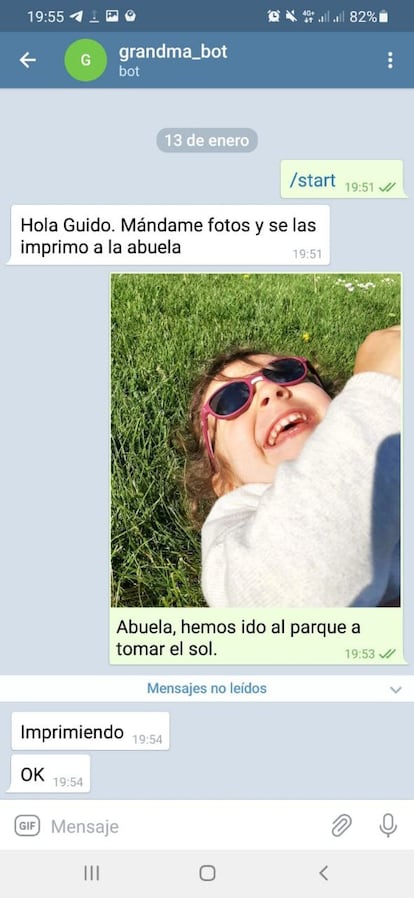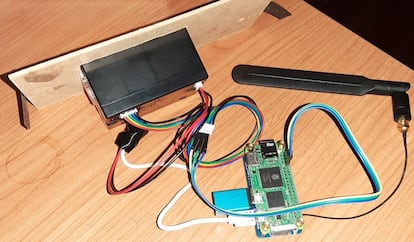The Spanish engineer who created a ‘WhatsApp’ for his grandma with no cellphone or Wi-Fi
Guido García has built a device with basic technology to print texts and photos for his 93-year-old grandmother. The entire contraption fits in a strawberry box

Telecommunications engineer Guido García misses his grandmother, 93-year-old Ludi. The coronavirus pandemic has prevented him from going to Basauri in the Vizcaya province of Spain’s Basque Country to see her for the last two Christmases. Nor can he communicate with her as he would like because, as he explains, Ludi “doesn’t want any hassle; no Wi-Fi, no cellphone.”
Consequently, García, who lives in Valladolid, has developed an ingenious device using basic technology so that the family can send Ludi texts and photos. The result is a kind of homemade WhatsApp that includes a small printer, a “mini computer” or Raspberry Pi the size of a credit card and a SIM card to connect it to the internet. Ludi only has to plug into the power supply and wait for the messages and photos to print out.
The images and texts are sent via the instant messaging site Telegram through a bot programmed by García. When he described the gadget he was creating on Twitter, more than 2,100 people retweeted it, 287 replied and more than 9,100 liked the tweet. “I was really surprised,” he tells EL PAÍS. “The one time something goes viral; it caught me off-guard.”
In a Twitter thread published on January 10, García gave a step-by-step explanation of how he built this WhatsApp at home so that his grandmother would not have to do anything at all. He programmed the bot in Telegram because, he says, “it is more flexible than WhatsApp which only lets companies make a bot; it has to be approved by Facebook and sending messages costs money.” With García’s gadget, a message or a photo is sent to the bot, and it gives the machine the order to print it out.
The Raspberry Pi “is more powerful than it looks,” says García. “It has half a gigabyte of RAM. A desktop computer can have up to four gigabytes, so it has limited capacities, but for this type of application or for home automation it is widely used because it has very low energy consumption, makes no noise and doesn’t heat up.”

The SIM card is used to connect to the internet and, therefore, to the bot. Since Ludi has no Wi-Fi or cellphone, this was the easiest way to achieve this. When someone sends her a photo or a message, she will receive it on paper without having to do anything more than pick it up from the printer. All the components are stored in a box that once contained strawberries. Now the project is finished, García just needs to take it to his grandmother so she can use it for the first time.
Although 20 hours was the goal García set himself in which to finish building the gadget, in the event, it took him 40. But getting together all the necessary components was neither difficult nor expensive: “The printer cost me about €50, the Raspberry Pi with the SIM, €20 in total, the communication plaque that carries the card, €70. I had no budget restrictions, but it can be done for less,” he says.
García looked for components in specialized computer stores and online, and acknowledges that he has noticed a shortage of chips and components. “There is less stock in some stores or the price has gone up a bit, but components such as Raspberry Pi are very common and you can find them in a lot of places,” he explains.

The engineer knows he is not a pioneer in homemade WhatsApps. He is familiar with the Yayagram, devised by the computer engineer Manuel Lucio from Burgos, and says: “I am not the first to do something like this, although, in this case, it has been even simpler. The Yayagram is a similar idea, but more elaborate as it is not a passive device.”
Thanks to his tweets, some Twitter users have proposed alternative ideas, and others have even asked him to make a WhatsApp gadget for them. “There’s been a great response,” he says. And though no one has written to him yet saying they have tried his idea, he is convinced that “anyone with a basic knowledge of electronics and programming can do it.”
Tu suscripción se está usando en otro dispositivo
¿Quieres añadir otro usuario a tu suscripción?
Si continúas leyendo en este dispositivo, no se podrá leer en el otro.
FlechaTu suscripción se está usando en otro dispositivo y solo puedes acceder a EL PAÍS desde un dispositivo a la vez.
Si quieres compartir tu cuenta, cambia tu suscripción a la modalidad Premium, así podrás añadir otro usuario. Cada uno accederá con su propia cuenta de email, lo que os permitirá personalizar vuestra experiencia en EL PAÍS.
¿Tienes una suscripción de empresa? Accede aquí para contratar más cuentas.
En el caso de no saber quién está usando tu cuenta, te recomendamos cambiar tu contraseña aquí.
Si decides continuar compartiendo tu cuenta, este mensaje se mostrará en tu dispositivo y en el de la otra persona que está usando tu cuenta de forma indefinida, afectando a tu experiencia de lectura. Puedes consultar aquí los términos y condiciones de la suscripción digital.
More information
Últimas noticias
Most viewed
- Reinhard Genzel, Nobel laureate in physics: ‘One-minute videos will never give you the truth’
- Oona Chaplin: ‘I told James Cameron that I was living in a treehouse and starting a permaculture project with a friend’
- Pablo Escobar’s hippos: A serious environmental problem, 40 years on
- Why we lost the habit of sleeping in two segments and how that changed our sense of time
- Chevy Chase, the beloved comedian who was a monster off camera: ‘Not everyone hated him, just the people who’ve worked with him’











































